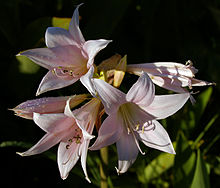| Amaryllis | |
|---|---|
 | |
| "Naked Lady" flowers in the Sinkyone Wilderness State Park, California. | |
| Scientific classification | |
| Kingdom: | Plantae |
| (unranked): | Angiosperms |
| (unranked): | Monocots |
| Order: | Asparagales |
| Family: | Amaryllidaceae |
| Tribe: | Amaryllideae |
| Subtribe: | Amaryllidinae |
| Genus: | Amaryllis |
| Species | |
| 2, including: Amaryllis belladonna Amaryllis paradisicola | |
Contents |
Characteristics
Amaryllis is a bulbous plant, with each bulb being 5–10 cm in diameter. It has several strap-shaped, green leaves, 30–50 cm long and 2–3 cm broad, arranged in two rows. The leaves are produced in the autumn or early spring in warm climates depending on the onset of rain and eventually die down by late spring. The bulb is then dormant until late summer. The plant is not frost-tolerant, nor does it do well in tropical environments since they require a dry resting period between leaf growth and flower spike production.From the dry ground in late summer (August in zone 7) each bulb produces one or two leafless stems 30–60 cm tall, each of which bears a cluster of 2 to 12 funnel-shaped flowers at their tops. Each flower is 6–10 cm diameter with six tepals (three outer sepals, three inner petals, with similar appearance to each other). The usual color is white with crimson veins, but pink or purple also occur naturally. The common name "naked lady" stems from the plant's pattern of flowering when the foliage has died down.[2]
The species was introduced into cultivation at the beginning of the eighteenth century. They reproduce slowly either by bulb division or seeds and have gradually naturalized from plantings in urban and suburban areas throughout the lower elevations and coastal areas in much of the West Coast of the USA since these environments mimic their native South African habitat.
Many bulbs sold as Amaryllis and described as 'ready to bloom for the holidays' actually belong to the allied genus Hippeastrum, despite being labeled as 'Amaryllis' by sellers and nurseries. Adding to the name confusion, some bulbs of other species with a similar growth and flowering pattern are also sometimes called this plant's common name "naked ladies". Some of those species have their own more widely used and accepted common names, such as the Resurrection Lily (Lycoris squamigera).
There is an Amaryllis belladonna × Crinum moorei cross, called × Amarcrinum [3], which has named cultivars.
The name
The botanic name Amaryllis is taken from a shepherdess in Virgil's pastoral "Eclogues", from the Greek ἀμαρύσσω (Latin amarysso) meaning "to sparkle."[4] It is also used as a given name for girls.The plant is also sometimes known as the "Jersey Lily".


No comments:
Post a Comment